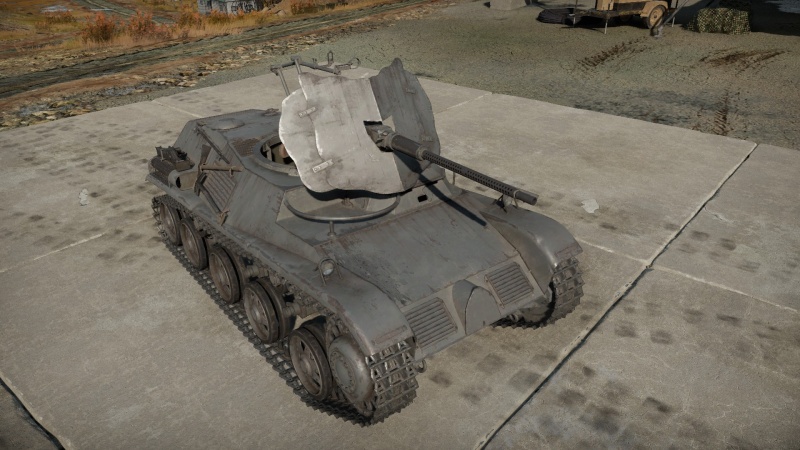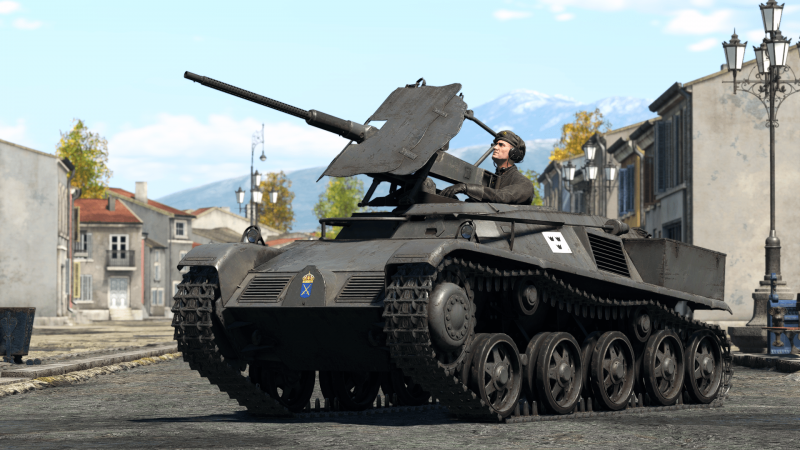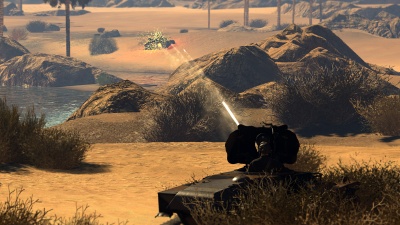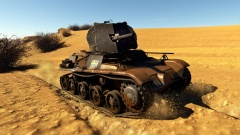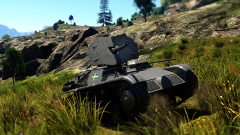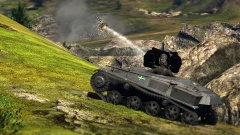Pvlvv fm/42
Contents
Description
The Pansarvärnslavettvagn fm/42 was a Swedish attempt at creating a self-propelled platform for the Bofors 20 mm anti-tank/anti-air autocannon L/70 (Swedish designation 20 mm automatkanon (akan) m/40). The idea was to reuse the chassis of the failed Landsverk L-120 prototype tankette and fit it with the aforementioned weapon to trial the concept. The trials were somewhat successful and would lead to the development of the Lvkv fm/43.
The Pansarvärnslavettvagn fm/42 (shortened Pvlvv fm/42) was introduced in Update 1.97 "Viking Fury" along with the initial Swedish ground tree. The Pvlvv fm/42 is a fast vehicle with a hard-hitting 20 mm cannon, making it a versatile vehicle. Its speed and manoeuvrability give it a feeling of driving a light tank with an autocannon similar to the Panzer II but with more vulnerability due to the exposed gunner and limited crew, making the Pvlvv fm/42 an easy vehicle to knock out. However, due to the 36-round drum and the versatility of the Lvakan m/40B cannons, it can deal with most opponents it will face, both on the ground and in the air.
General info
Survivability and armour
The Pvlvv fm/42 is a fairly weak vehicle in terms of survivability, at least in Realistic and Simulator modes where it will be knocked out after losing one crew member. It features no meaningful protection from any angle, with only 10 mm of armour protecting the front of the hull and 16 mm of effective armour protecting the gunner. This armour is superficial really, as even heavy machine guns will have no trouble getting through the armour of the vehicle, and seeing as it's only manned by two crew, a shot through the flat armour of the drivers port will easily knock the vehicle out of action. Additionally as it's open-topped, it's very vulnerable from the air, and the gun can't angle directly upwards, meaning the gun shield can't be used to protect against enemy aircraft. This vehicle may survive a poorly placed shot, but most of the time the armour is not in any way reliable.
In Arcade, it is far better. The light armour and spaced out crew means shots are unlikely to kill both crew at once, while the gun shield and enclosed driver provides average protection for a Rank I SPAA. While crew replenishing, the gun also works despite the gunner being knocked out, meaning the vehicle can defend itself even after some penetrating hits.
Armour type:
- Rolled homogeneous armour
- Cast homogeneous armour (gun mantlet)
| Armour | Front (Slope angle) | Sides | Rear | Roof |
|---|---|---|---|---|
| Hull | 10 mm (18-28°) Upper plate 6 mm (73°) Upper glacis 8 mm (46-50°) Lower glacis |
8 mm (34°) Top 13 mm Front 8 mm (24°) Bottom |
8 mm (21°) Upper plate 8 mm (26°) Lower plate |
6 mm (17°) Front glacis 5 mm Crew compartment 5 mm (9°) Engine compartment |
| Gun shield | 13 mm (28°) |
Notes:
- Suspension wheels and torsion bars are 10 mm thick, while tracks are 15 mm thick.
- Belly armour is 5 mm thick.
Mobility
| Game Mode | Max Speed (km/h) | Weight (tons) | Engine power (horsepower) | Power-to-weight ratio (hp/ton) | |||
|---|---|---|---|---|---|---|---|
| Forward | Reverse | Stock | Upgraded | Stock | Upgraded | ||
| Arcade | Expression error: Unexpected * operator. | 121 | Expression error: Unexpected round operator. | __.__ | |||
| Realistic | 75 | Expression error: Unexpected round operator. | __.__ | ||||
The mobility and speed of the Pvlvv fm/42 is fairly effective, it won't outpace many enemy light vehicles around this battle rating but it is fast enough to get where it needs to be in the map without much trouble. Off-road it can cruise at a max of 54 / 38 km/h (AB/RB), making it one of the fastest Swedish ground vehicles at its rank. It can change direction and manoeuvre well enough, and has a reverse speed of -6 km/h, which isn't vastly impressive, but is enough to occasionally get the vehicle out of trouble. However, as the engine is fairly weak it will struggle to climb steep hills, so try to approach these obstacles at an angle to increase the friction on the tracks.
Modifications and economy
Armaments
Main armament
The Pvlvv fm/42 is equipped with the m/40B 20 mm cannon, which sports effective performance against tanks and aircraft if the rounds hit, and especially regarding aircraft - that's not an easy task. The cannon can only elevate to 45 degrees, which commonly isn't enough to get an attack angle on most aircraft as they will be flying too high up, making this quite a tedious anti-air vehicle to use in its intended role.
| 20 mm lvakan m/40B | Turret rotation speed (°/s) | Reloading rate (seconds) | ||||||||||||
|---|---|---|---|---|---|---|---|---|---|---|---|---|---|---|
| Mode | Capacity (Belt) | Fire rate | Vertical | Horizontal | Stabilizer | Stock | Upgraded | Full | Expert | Aced | Stock | Full | Expert | Aced |
| Arcade | 108 (36) | 360 | -10°/+45° | ±180° | N/A | 25.01 | 34.61 | 42.03 | 46.48 | 49.45 | 1.30 | 1.15 | 1.06 | 1.00 |
| Realistic | 16.90 | 19.88 | 24.14 | 26.70 | 28.40 | |||||||||
Ammunition
A further drawback of this vehicle's armament is the total ammo count at only 108 rounds with the possibility of taking 3 belts. This hugely limits its performance, especially against aircraft as acquiring the lead will usually take a fair few shots. By the time a critical shot is landed, most of the ammo will likely be gone. For this reason, it's not recommended to take a magazine of the full HE belt, as this will take up a third of the Pvlvv fm/42's total potential ammo, meaning a third of the shots will have no effect against enemy ground targets, and given that attacking ground vehicles is a more adept method of play for this vehicle, it is best to maximise the Pvlvv fm/42's anti-tank ability. The AP belt can cut through a max of 42 mm of flat armour, so at close range the vehicle will have no trouble knocking out the majority of enemy vehicles.
Once unlocked, it's recommended to take either three belts of AP rounds, or two belts of AP rounds with one Default belt for engaging aircraft, as the belt is still effective against both types of targets. Players can switch between this belt easily as well as the reload for changing belts is only 1.3 seconds.
- Default: AP-T · HEFI-T · HEFI-T - A 2-to-1 mix of HE and AP rounds, an effective, versatile belt.
- slsgr m/42: HEFI-T - Ineffective against ground vehicles but adequate for aircraft.
- slpgr m/42: AP-T - Very effective against ground vehicles while still being able to damage aircraft.
| Penetration statistics | |||||||
|---|---|---|---|---|---|---|---|
| Ammunition | Type of warhead |
Penetration @ 0° Angle of Attack (mm) | |||||
| 10 m | 100 m | 500 m | 1,000 m | 1,500 m | 2,000 m | ||
| Default AP-T | AP-T | 42 | 40 | 30 | 22 | 16 | 11 |
| slsgr m/42 | HEFI-T | 5 | 4 | 3 | 2 | 2 | 2 |
| slpgr m/42 | AP-T | 42 | 40 | 30 | 21 | 15 | 10 |
| Shell details | ||||||||||||
|---|---|---|---|---|---|---|---|---|---|---|---|---|
| Ammunition | Type of warhead |
Velocity (m/s) |
Projectile mass (kg) |
Fuse delay (m) |
Fuse sensitivity (mm) |
Explosive mass (TNT equivalent) (g) |
Ricochet | |||||
| 0% | 50% | 100% | ||||||||||
| Default AP-T | AP-T | 815 | 0.15 | - | - | - | 47° | 60° | 65° | |||
| slsgr m/42 | HEFI-T | 845 | 0.14 | 0.1 | 0.1 | 10.2 | 79° | 80° | 81° | |||
| slpgr m/42 | AP-T | 845 | 0.14 | - | - | - | 47° | 60° | 65° | |||
Ammo racks
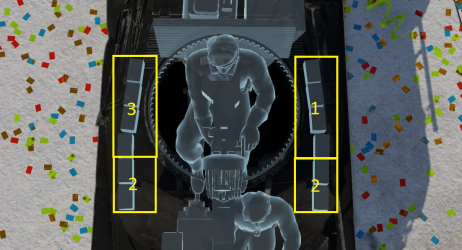
| Full ammo |
Ammo type |
1st rack empty |
2nd rack empty |
3rd rack empty |
Visual discrepancy |
|---|---|---|---|---|---|
| 3 180 |
Belts Rounds |
2 (+1) 72 (+36) |
1 (+2) 36 (+72) |
0 (+3) 0 (+108) |
No |
Notes:
- Ammunition is modelled as 12 boxes of 9 rounds. A belt represents 36 rounds.
- Since the total ammo count is low, it is recommended to carry the maximum.
- Playing in the vicinity of an allied capture point will help restock while in-game.
Usage in battles
Anti air:
The lack of elevation for the cannon makes engaging aircraft tricky and sometimes impossible if the map is quite flat, as to engage aircraft this vehicle needs to be positioned on high ground or at an angle on the terrain. In general, it's not recommended to attempt to engage aircraft unless the player is confident that the plane can be taken out in one burst, as if an enemy aircraft notices the Pvlvv fm/42, they'll also likely know the Pvlvv fm/42's flaw of being unable to elevate the gun very high, so they will simply dive right down on top of the vehicle to strafe out the crew, which is a fairly easy task as from the top the crew have no protection. Therefore, the player needs to pay constant attention to the locations and distances of enemy aircraft, and always face th gun shield to them to avoid having the gunner exposed and strafed.
Due to the extremely limited ammo capacity, this SPAA cannot enjoy the luxury of spraying shells at low-flying planes. The most potent way of downing planes is to do head-on with them as this method uses little ammo. First, locate an enemy plane and fire single shots towards their flight path. These shots would certainly miss but will hopefully get the plane's attention. Most planes might choose to strafe an SPAA for an easy kill. If they do start flying towards you, immediately enter gunner view and zoom in. This SPAA has a very good gunsight, allowing the player to clearly view a target precisely track it. As the plane dive at you, aim slightly upwards at it (at the tip of its vertical stabiliser) to compensate for shell drop. The more vertical the dive is, the closer you should aim for the very centre of the fuselage. Then give a 1-second burst while very slightly moving the mouse up and down to enlarge your shell spread, increasing the chance of scoring hits. Of course do not spread too much, the shells should be concentrated at and around the fuselage. Usually 2-4 hits will guarantee a critical hit if not a kill.
Note that even if the player has the 'camera from tank gunner view' ticked off (gun camera will be within gun barrel), the gun camera's location of this SPAA will still be below the barrel. Therefore if the target is close, aim down a bit to compensate for such layout.
Anti tank:
Despite being classed as an SPAA vehicle, it truly excels at fighting ground vehicles. As this vehicle has very little ammunition, engaging ground vehicles allows the Pvlvv fm/42 to potentially maximise its shots on target. Engaging aircraft usually results in lots of missed shots, which largely isn't too much of a problem generally for SPAA as they're usually equipped with lots of ammunition, but as this vehicle isn't, all shots need to count, and as such leading shots on ground targets is much more consistent that it is the recommended way to play.
At close range, the AP belt will be able to deal with most enemy vehicles easily, though it will struggle with some French vehicles such as the B1 bis, S.35, and even some of the reserve vehicles. It's important to know the enemy and only engage if absolutely certain the gun can cause critical damage. Don't waste shots and avoid being destroyed, so learning the general armour layout of the enemies is an important factor here.
Aim to play around close-range sight-lines if possible, in these locations, shots will be easier to aim and the 20 mm rounds will have more penetration which is important to consider as their penetration performance drops off considerably at distances, at 500 m the shots can only cut through 30 mm of flat armour which isn't enough to deal with most enemies quickly if at all.
Luckily, as this vehicle is quite small, it's fairly easy to slip around the map unnoticed, and allows the Pvlvv fm/42 to be able to hide in nooks and corners to ambush the enemy. Waiting in ambush at close range, around a cap or watching a corner, is the safest, most consistent way to play the Pvlvv fm/42. Although if confident, the Pvlvv fm/42 can simply drive around in a manner similar to that of a conventional tank by spraying enemies down with the autocannon at close range without necessarily aiming, as it's quite likely the gunfire will disable them before the can fire back. Playing this way is certainly possible, but due to how weak this vehicle is, it's only recommend if the Pvlvv fm/42 player is very confident and have the vehicle fully upgraded. Do also be mindful of playing around very combat heavy areas, as these locations are commonly rife with artillery fire which this vehicle is hugely weak to, so aim to engage at close-range still, but try to avoid the bulk of combat, utilise side roads and pathways out of the way to creep up to enemies on their sides. Additionally, if possible, try to play close to friendly capture points, as the Pvlvv fm/42 can use them to replenish its ammo supply which will be vital in long matches.
Pros and cons
Pros:
- Decent mobility
- Extremely fast reload allows the Pvlvv fm/42 to nearly seamlessly fire off two magazines before the gun finally overheats and jams
- Single magazine rearm on a capture point takes about 4 seconds, which allows SPAA to completely resupply while fighting back
- Effective anti-tank performance, particularly in flanking manoeuvres
- Reasonably high rate of fire
- Large drum capacity of 36 rounds
- Great gunsight zoom
- Less noticeable than truck SPAAs of other nations (irrelevant in AB)
Cons:
- Overall low ammo count
- Rate of fire is high enough to overwhelm light vehicles, but isn't high enough to just obliterate tanks or to crash down planes by firing randomly, steady aim is required
- Poor survivability due to low crew count and vulnerability to rifle-calibre machine guns from the sides and the back
- Insufficient elevation for the cannon, often unable to fire at planes which are attacking from above
History
Not much is known about this tank since only one was ever built and never put into active service. The project went under the generic name 20 mm pansarvärnsluftvärnsbandlavettage (20 mm anti-tank, anti-air, tracked-mount), which can be abbreviated to 20 mm pvlvblav using the Swedish abbreviation system, which was a project to trial the concept of a self-propelled anti-air gun. The Swedish army had briefly trialled the Landsverk L/62 Anti I in the late '30s but no orders were made. However, with the start of WWII, it became clear that the Swedish tank units needed self-propelled anti-air support. Initially it was unknown what type of weapon was needed. On one side there was the quick firing 20 mm Bofors L/70 gun which was effective at short range engagements, and on the other side was the slower firing 40 mm Bofors L/60 gun which was effective at medium range engagements. In the end it was decided to trial both systems on self-propelled platforms.
As the end-goal was to produce an anti-air vehicle for the Swedish tank units, it was preferred if the trial vehicles were armoured and had the same mobility as the tanks. However to save money it was decided to use existing chassis for the trial vehicles instead of building new dedicated designs. The size of the 40 mm Bofors L/60 meant that it was too big for any existing tank chassis available, and had to be mounted on a terrain truck for trials. A few vehicles were built and one of these vehicles became the Lvtdgb m/40. The 20 mm Bofors L/70 however was small enough to be fitted to an existing tank chassis. As to not use up an in service tank chassis it was decided to use the chassis of the failed Landsverk L-120 tankette prototype, which had competed against the Czech CKD AH-IV tankette to become the strv m/37 and lost due to time constraint and cost.
The L-120 tankette was effectively and visually a downscaled Landsverk L-60 (the basis for the strv m/38, strv m/39 & strv m/40L), but with a 2 man crew and a small turret fitted with two 8 mm machine guns. To trial the 20 mm SPAAG concept the old turret had to be removed. In place of the turret an open turret ring was fitted. On this turret ring a seat and 20 mm mount was fitted. The 20 mm mount was an existing mount used for the 20 mm Bofors L/70, which had been cut down and modified to fit the turret ring and allow elevation of the gun from the seat. The mount had also been fitted with a large armoured shield in front of it to protect the gunner from frontal small arms fire and fragmentation.
The final trial vehicle was trialled sometime around 1942 but not much information is available on its actual tests. The trials seems to have gained some positive results however, as the Swedish army did order an anti-air tank in 1943 that was to be fitted with 2-3 x 20 mm Bofors L/70 cannons in an armoured turret. This vehicle would eventually evolve into the lvkv fm/43 SPAAG, which during its development traded the 20 mm guns for two 40 mm Bofors L/60 guns.
What happened to the "Pvlvv fm/42" trial vehicle is not known but it was probably used as a target on a target range like so many other vehicles of its type.
Media
- Skins
- Images
See also
External links
Paste links to sources and external resources, such as:
- topic on the official game forum;
- other literature.
| AB Landsverk | |
|---|---|
| Light Tanks | |
| L-10 | Strv m/31 |
| L-60 | Strv m/38 · Strv m/39 · Strv m/40L |
| Pbil m/40 | Pbil m/40 |
| Strv 74 | Strv 74 |
| Unimog 404 | U-SH 405 |
| Medium Tanks | |
| Lago | Lago I · Strv m/42 EH · Ikv 73 · Strv m/42 DT |
| Tank Destroyers | |
| Ikv 72 | Ikv 72 · Ikv 103 |
| Pvkv m/43 | Pvkv m/43 (1946) · Pvkv m/43 (1963) |
| Pvkv II/III | Pvkv II · Pvkv III |
| SPAA | Pvlvv fm/42 · L-62 ANTI II |
| Sweden anti-aircraft vehicles | |
|---|---|
| SPAA | Pvlvv fm/42 · Lvtdgb m/40 · Pbv 301 · Lvkv 42 · U-SH 204 GK |
| Radar SPAA | VEAK 40 · Lvkv 9040C |
| SAM | Lvrbv 701 · ASRAD-R |
| Finland | L-62 ANTI II · ▄ZSU-57-2 · ItO 90M · ItPsV Leopard |



